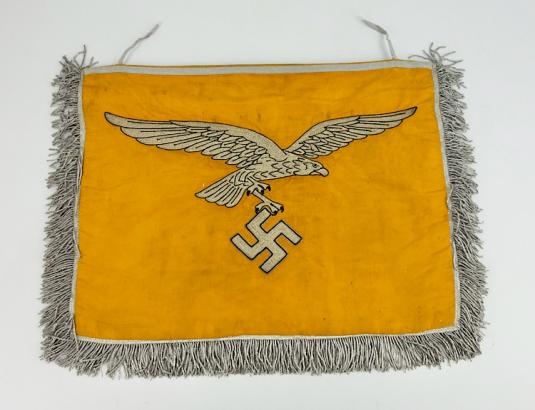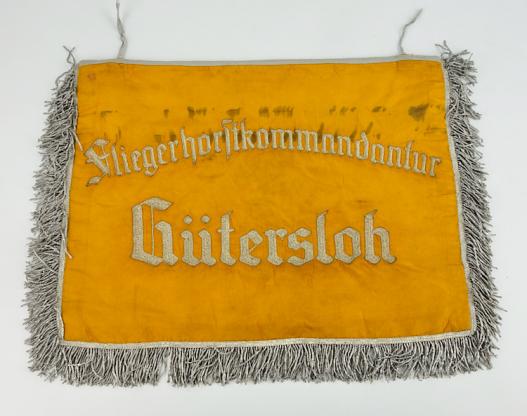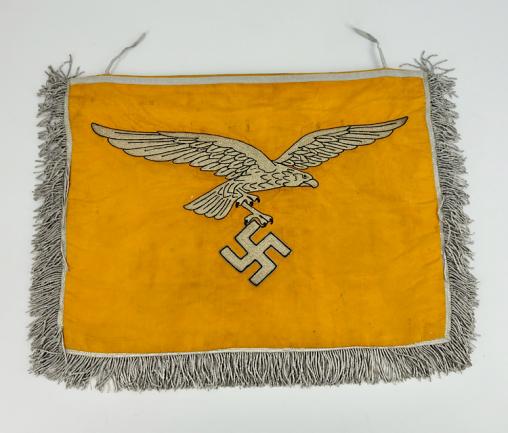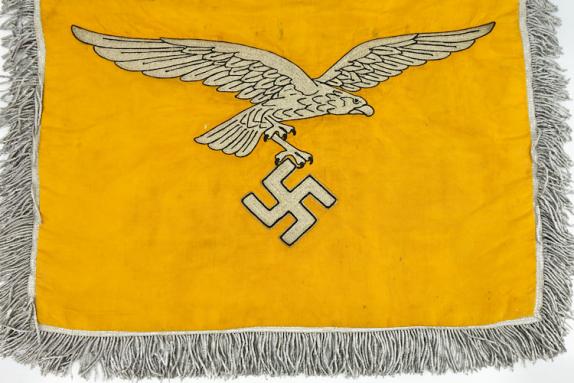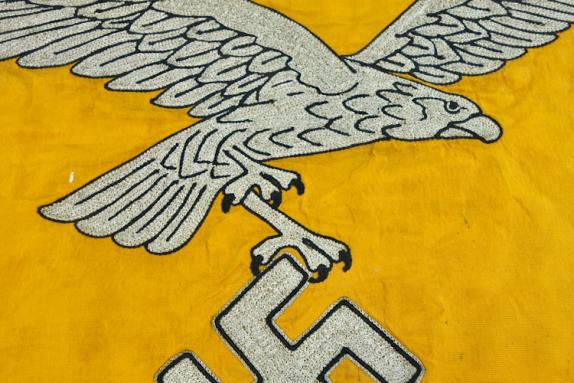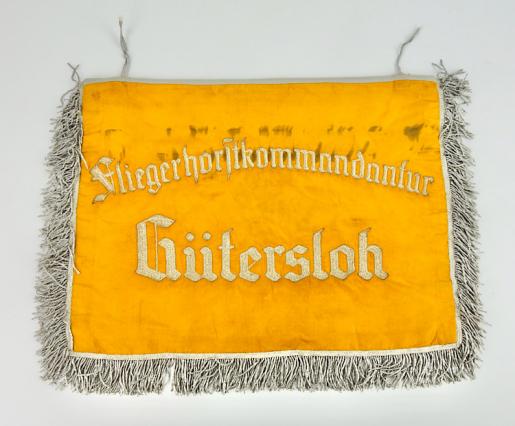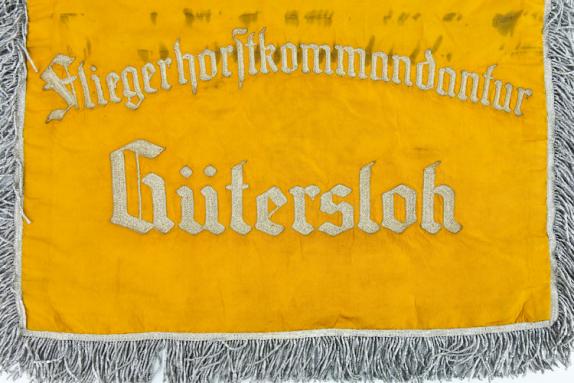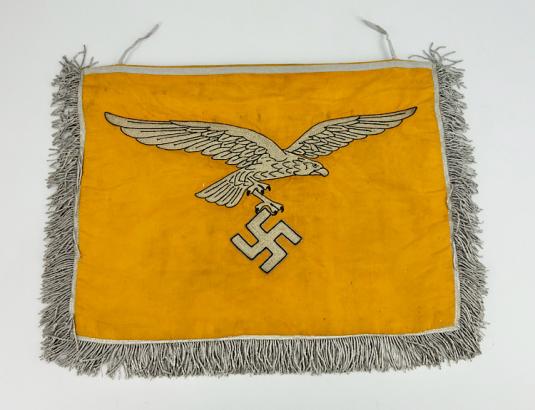Luftwaffe Trumpet Banner
Luftwaffe Trumpet Banner
“Fliegerhorst Kommandantur Gütersloh”
Air Force Air Base
Location on the edge of the urban area
In 1935 the construction of the airfield for the air force of the newly founded Wehrmacht started, the overburden - here was the highest ice age inland dune of Gütersloh - was used for the construction of the Reichsautobahn (today's A2). The airfield was opened in April 1937.
In May 1939 the 2nd group of Combat Squadron 28 was set up here. In the winter of 1939/40, the second group of Combat Squadron 54 followed, which was involved in the air raid on Rotterdam on May 14, 1940. Between June 1940 and March 1941, the 1st group of Night Fighter Squadron 1 (I./NJG 1) was located here. In 1942, LSV Gütersloh, which was founded by members of the Air Force, took part in the Tschammer Cup in football. From 1943 dead in 1945 units of the Reich Defense were stationed in Gütersloh, including the night hunting officer Kommodore Heinz-Wolfgang Schnaufer with his staff and the 2nd group of the night hunting squadron 4 (II./NJG 4) between November 1944 and March 1945. In April 1944 there was a bomb attack on the airfield, and more followed until the end of March 1945.
The last two German planes are said to have taken off on March 30, 1945 in the direction of Wunstorf. This obviously also included Schnaufer's replacement aircraft, a Bf 110, the aircraft driver of which crash-landed in the Kirchdornberg area after fighter-bomber fire. The rest of a tail unit, "decorated" with all launches, was privately owned for decades and was auctioned in 2015.
The following table shows the complete list of all active flying units (excluding school and supplementary units) of the Air Force of the Wehrmacht, which were stationed here between 1937 and 1945
Von Bis
April 1937/October 1938 IV./KG 254 (IV. Gruppe des Kampfgeschwaders 254)
November 1938/April 1939 II./KG 254
Mai 1939/November 1939 II./KG 28 Heinkel He 111P
September 1939/Februar 1940 Stab/KG 54 Heinkel He 111P
November 1939/Dezember 1939 I., II./JG 77 (I. und II. Gruppe des Jagdgeschwaders 77) Messerschmitt Bf 109E
Februar 1940/März 1940 I./KG 4 Heinkel He 111P
März 1940/April 1940 II./KG 27 Heinkel He 111P
Mai 1940/Mai 1940 II./ZG 1 (II. Gruppe des Zerstörergeschwaders 1) Messerschmitt Bf 110
Mai 1940/Mai 1940 III./KG z. b. V. 1 (III. Gruppe des Kampfgeschwaders zur besonderen Verwendung) Junkers Ju 52/3m
Mai 1940/Mai 1940 Aufkl.St. Fliegerdivision 7 (Aufklärungsstaffel der 7. Fliegerdivision)
Mai 1940/Juni 1940 II./KG 54 Heinkel He 111P
Juli 1940 März 1941 I./NJG 1 (I. Gruppe des Nachtjagdgeschwaders 1) Messerschmitt Bf 110, Dornier Do 17Z
November 1941/Mai 1942 III./KG 3 Dornier Do 17Z, Junkers Ju 88A
1941 1942 Überführungskdo. Gütersloh
1942 1944 Flugzeugschleuse Mittle/Luftflottenkdo. Reich
Mai 1944/August 1944 II./NJG 5 Messerschmitt Bf 110F-4
Juni 1944/Juni 1944 II./JG 2 Messerschmitt Bf 109G-6
Juli 1944/Juli 1944 I./JG 3 Messerschmitt Bf 109G-6
August 1944/August 1944 II./NJG 3 Junkers Ju 88G-1
September 1944/Oktober 1944 II./JG 27 Messerschmitt Bf 109G-6, Messerschmitt Bf 109G-14
September 1944/November 1944 III./NJG 2 Junkers Ju 88G-1, Junkers Ju 88G-6
September 1944/Oktober 1944 Stab/JG 11 Messerschmitt Bf 109G-14
Oktober 1944/December 1944 Stab, II./SG 4 Focke-Wulf Fw 190F-8
November 1944/März 1945 II./NJG 4 Junkers Ju 88G-1
Dezember 1944/Januar 1945 IV./JG 3 Focke-Wulf Fw 190A-8
März 1945/März 1945 III./JG 27 Messerschmitt Bf 109K
Anfang April 1945 wurde der Fliegerhorst durch die US Army eingenommen und als Airfield Y.99, so die alliierte Codebezeichnung des Flugplatzes vom 6. April bis zum 22. Juni 1945 von der United States Army Air Forces (USAAF) genutzt. Im April waren die 125th Liaison Squadron und die mit F-6 Mustang und F-5 Lightning 363d Tactical Reconaissance Group die ersten alliierten Nutzer des notdürftig hergerichteten Flugplatzes. Als dritter fliegender US-Verband lag die mit P-51 Mustang ausgerüstete 370th Fighter Group vom 20. April bis 27. Juni 1945 in Gütersloh. Die Verbindungsstaffel nutze auch die Behelfspiste im Ortsteil Avenwedde (siehe auch Abschnitt 4).
Im Juni 1945 wurde der Flugplatz schließlich an die britische Besatzungsmacht übergeben, womit eine 71-jährige Nutzungsphase als Militärstandort des Vereinigten Königreichs begann.
The Trumpet Banner was a US veteran bring back and is in used but very good condition.
Fantastic decorative piece of history.
Great item for every WW2 collector
Code: 64654
2995.00 EUR




